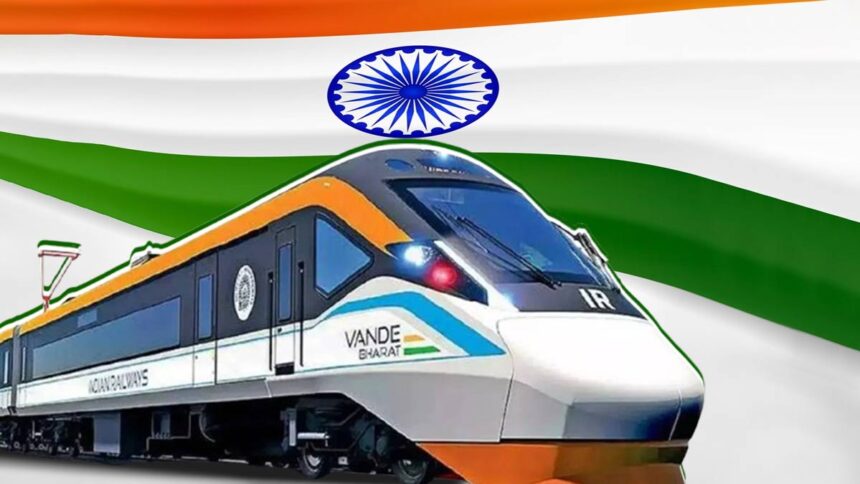Cambodia to Import 45 Vande Bharat Train Coaches from Indian Railways: Highlighting India’s Role as a Global Railway Technology Exporter and the Vande Bharat Flagship Train
Introduction
Cambodia is making a major move in transportation. The country just announced plans to import 45 Vande Bharat train coaches from Indian Railways. This is more than just a deal; it signals India’s rise as a key player in railway technology export. The Vande Bharat train is now seen as India’s flagship rail project. Its reputation for speed, comfort, and modern design is spreading worldwide.
This deal shows how India’s railway industry is going beyond borders. It reflects India’s growing influence as a hub of innovative rail solutions. For Cambodia, this is a vital step toward modernizing its transit system. For India, it’s a chance to showcase its engineering skills on the global stage.
What Is Vande Bharat?
- Launched on 15 February 2019, the Vande Bharat Express (formerly Train 18) is India’s indigenously designed, air‑conditioned semi‑high‑speed electric multiple unit (EMU) developed by the Integral Coach Factory (ICF), Chennai.
- Built in 18 months with ~80% local content, the train is capable of reaching speeds of 160 km/h in service, with a top trial speed of 180 km/h+, and accelerates from 0–100 km/h in just 52 seconds – faster than some Japanese bullet trains.
- Features include automatic doors, onboard Wi‑Fi, infotainment systems, rotatable executive‑class seats, bio‑vacuum toilets, GPS‑based passenger information, CCTV, and LED lighting.
- With hundreds of coaches and multiple trainsets in service, Vande Bharat now forms the backbone of India’s modern domestic rail services.
India’s Emergence as a Leading Railway Technology Exporter
Growing Global Demand for Modern Railway Solutions
Across the world, countries want faster, safer, and more efficient trains. As urban populations rise, so does the need for reliable rail systems. Many nations look to India, which has developed impressive train technology. Compared to traditional exporters like China and Japan, India offers cost-effective yet innovative solutions. The global railway market is booming, and India’s share keeps growing.
India’s Strategic Initiatives in Rail Infrastructure Exports
The Indian government launched programs like Make in India and Atmanirbhar Bharat. These policies encourage local industries to develop exports, including trains and components. India has already signed major contracts with countries in Africa, Southeast Asia, and the Middle East. These deals help build new rail networks and modern trains in many nations.
Impact of International Contracts on India’s Railway Sector
International deals like Cambodia’s import of Vande Bharat coaches boost India’s domestic industry. They push local companies to improve technology and manufacturing quality. Plus, exports open doors to more markets. As more countries adopt Indian railway technology, India’s industry becomes stronger and more competitive.
Building on Institutional Experience
The Modern Coach Factory (MCF) in Rae Bareli is set to release its first Vande Bharat rake by early 2025, exemplifying India’s expanded manufacturing base beyond ICF and RCF.
The PLI scheme promotes a domestic ecosystem for these coaches, ensuring Cambodia obtains cost-effective, high-quality equipment.
Broader Impacts: India’s Rising Rail Exports
Expanding Export Portfolio
India has extended coach and component exports to more than 16 countries, including UK, France, Saudi Arabia, Australia, Mozambique, Bangladesh, Sri Lanka, Nigeria, and Tanzania.
These exports include:
- Passenger coaches to Mozambique, Bangladesh, Sri Lanka.
- Locomotives to Mozambique, Senegal, Sri Lanka, Myanmar, Bangladesh.
- Underframes & bogie frames for UK (Aventra), Saudi Arabia (Riyadh metro), France (SNCF), Australia.
- Propulsion systems for rolling-stock projects in France (TGV), Mexico, Romania, Spain, Germany, Italy.
The Vande Bharat Train: India’s Flagship Rail Innovation
Design and Features of the Vande Bharat
Vande Bharat trains are known for their sleek appearance and comfort. They combine high speed with eco-friendly features. The trains can reach speeds up to 180 km/h (112 mph). They have modern interiors with spacious seating, large windows, and onboard amenities. Little things, like automatic doors and improved suspension, make rides smoother. These details help Vande Bharat stand out on the global stage.
The Success and Global Reputation of Vande Bharat
Since its launch, Vande Bharat trains have been running across India. They quickly gained fans for their speed and comfort. Countries seeking modern train solutions are taking notice. Egypt, UAE, and now Cambodia are interested in adopting similar trains. This recognition helps position India as a top railway winner in emerging markets.
Vande Bharat as a Model for Railway Modernization in Developing Countries
Vande Bharat offers a smart way to upgrade rail systems without costing a fortune. Its design makes high-speed travel affordable for countries with limited budgets. Some examples show how these trains connect cities better, boost local economies, and reduce congestion. For developing nations, Vande Bharat may soon be the new blueprint for transportation.
Cambodia’s Strategic Move to Modernize Rail Transport
Context and Motivation Behind the Import
Cambodia wants to grow its economy and improve transportation. Rail is key to connecting cities, ports, and neighboring countries. Better rail links can cut costs, move goods faster, and attract more tourists. The import of Vande Bharat coaches is part of this bigger plan to modernize infrastructure.
Details of the Import Agreement and Deployment Plans
The plan is to have Indian coaches assembled in Cambodia within the next year. After that, they’ll be tested and become part of Cambodia’s train routes. These coaches will serve both passenger and freight needs, helping the country handle more traffic smoothly. This project could transform the local rail system, sparking economic growth.
Broader Implications for Cambodia and Regional Connectivity
Cambodia’s move opens doors for regional rail networks that include India, Thailand, Vietnam, and other neighbors. It could lead to new rail corridors and faster trade routes. As Indian tech spreads, Cambodia might soon become a hub for more railway collaborations, opening new markets for Indian firms and tech transfer.
India-Cambodia Rail Partnership: Significance and Future Outlook
Strengthening Bilateral Relations Through Rail Collaboration
Infrastructure projects like this lift diplomatic ties. They build trust and show mutual interest in development. Strong rail connections make it easier for India and Cambodia to work together on other regional issues. Rail projects can be the foundation for long-lasting partnership.
Expanding Indian Railway Technology Exports in Southeast Asia
This deal is just the start. More countries in Southeast Asia could follow Cambodia’s lead. India’s railway tech, including trains and components, could become a staple in the region. This fits perfectly with India’s “Act East” policy, which aims to boost regional ties.
Opportunities for Local Capacity Building and Skill Development
Indian companies will likely train local workers, creating jobs. Cambodia’s workforce will learn maintenance, operations, and train technology. This knowledge transfer helps build local skills and ensures long-term success for these projects. It’s a local win wrapped in a regional deal.
Conclusion
Cambodia’s plan to import 45 Vande Bharat coaches marks a major milestone in international railway cooperation. It highlights India’s growing role as a global railway technology exporter. The Vande Bharat train’s reputation makes it a symbol of India’s engineering strength.
Looking ahead, India and Cambodia can deepen their railway partnership. This project paves the way for more regional rail links, boosting travel, trade, and economic growth. For policymakers and industry leaders, it’s clear—India’s rail tech has the potential to change the way developing nations upgrade their transportation systems. The future of rail in Southeast Asia looks brighter with India steering the way.

